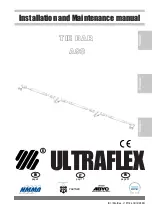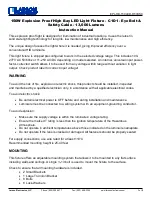
SAFETY, ENVIRONMENTAL, AND REGULATORY INFORMATION
VB-8054
4-Channel, 500 MHz Bandwidth Oscilloscope VirtualBench
™
(All-In-One Instrument)
This document includes compliance precautions and connection information for the VB-8054.
Note
The guidelines in this document are specific to the VB-8054.
Safety Guidelines
The following section contains important safety information that you must follow when installing and using the VB-8054.
Do not operate the hardware in a manner not specified in this document and in the user documentation. Misuse of the hardware can result in a hazard. You can
compromise the safety protection if the hardware is damaged in any way. If the hardware is damaged, return it to National Instruments for repair.
Hazardous Voltage
This icon denotes a warning advising you to take precautions to avoid electrical shock.
Caution
Do not operate the VB-8054 in a manner not specified in this document. Product misuse can result in a hazard. You can compromise the
safety protection built into the product if the product is damaged in any way. If the product is damaged, return it to National Instruments for repair.
Clean the hardware with a soft, nonmetallic brush. Make sure that the hardware is completely dry and free from contaminants before returning it to service.
Do not substitute parts or modify the hardware except as described in the
NI VirtualBench Help
. Use the hardware only with the accessories and cables
specified in the
NI VirtualBench Help
or
NI VirtualBench VB-8054 Specifications
.
Do not operate the hardware in an explosive atmosphere or where there may be flammable gases or fumes.
You must insulate signal connections for the maximum voltage for which the hardware is rated. Do not exceed the maximum ratings for the hardware. Do not
install wiring while the hardware is live with electrical signals. Do not remove or add connector blocks when power is connected to the system. Avoid contact
between your body and the connector pins when hot-swapping hardware. Remove power from signal lines before connecting them to or disconnecting them
from the hardware.
Operate the device only at or below Pollution Degree 2. Pollution is foreign matter in a solid, liquid, or gaseous state that can reduce dielectric strength or
surface resistivity. The following is a description of pollution degrees:
• Pollution Degree 1 means no pollution or only dry, nonconductive pollution occurs. The pollution has no influence.
• Pollution Degree 2 means that only nonconductive pollution occurs in most cases. Occasionally, however, a temporary conductivity caused by condensation
must be expected.
• Pollution Degree 3 means that conductive pollution occurs, or dry, nonconductive pollution occurs that becomes conductive due to condensation.
Operate the DMM on the device at or below Measurement Category II
1
. Operate the mixed signal oscilloscope, function generator (FGEN), external trigger
(TRIG), digital I/O, and DC power supply on the device at or below Measurement Category I. Measurement circuits are subjected to working voltages
2
and
transient stresses (overvoltage) from the circuit to which they are connected during measurement or test. Measurement categories establish standard impulse
withstand voltage levels that commonly occur in electrical distribution systems. The following is a description of measurement categories:
• Measurement Categories CAT I and CAT O (Other) are equivalent and are for measurements performed on circuits not directly connected to the electrical
distribution system referred to as MAINS
3
voltage. This category is for measurements of voltages from specially protected secondary circuits. Such voltage
measurements include signal levels, special equipment, limited-energy parts of equipment, circuits powered by regulated low-voltage sources, and
electronics.
• Measurement Category II is for measurements performed on circuits directly connected to the electrical distribution system. This category refers to local-
level electrical distribution, such as that provided by a standard wall outlet (for example, 115 V for U.S. or 230 V for Europe). Examples of Measurement
Category II are measurements performed on household appliances, portable tools, and similar E Series devices.
• Measurement Category III is for measurements performed in the building installation at the distribution level. This category refers to measurements on hard-
wired equipment such as equipment in fixed installations, distribution boards, and circuit breakers. Other examples are wiring, including cables, bus-bars,
junction boxes, switches, socket-outlets in the fixed installation, and stationary motors with permanent connections to fixed installations.
• Measurement Category IV is for measurements performed at the primary electrical supply installation (<1,000 V). Examples include electricity meters and
measurements on primary overcurrent protection devices and on ripple control units.
To obtain the safety certification(s) for this product, visit
, search by model number or product line, and click the appropriate link in the
Certification column.
Safety Voltages
Connect only voltages that are within these limits.
1
Measurement Category is defined in electrical safety standard IEC 61010-1. Measurement Category is also referred to as Installation Category.
2
Working voltage is the highest rms value of an AC or DC voltage that can occur across any particular insulation.
3
MAINS is defined as a hazardous live electrical supply system that powers equipment. Suitably rated measuring circuits may be connected to the MAINS
for measuring purposes.






















